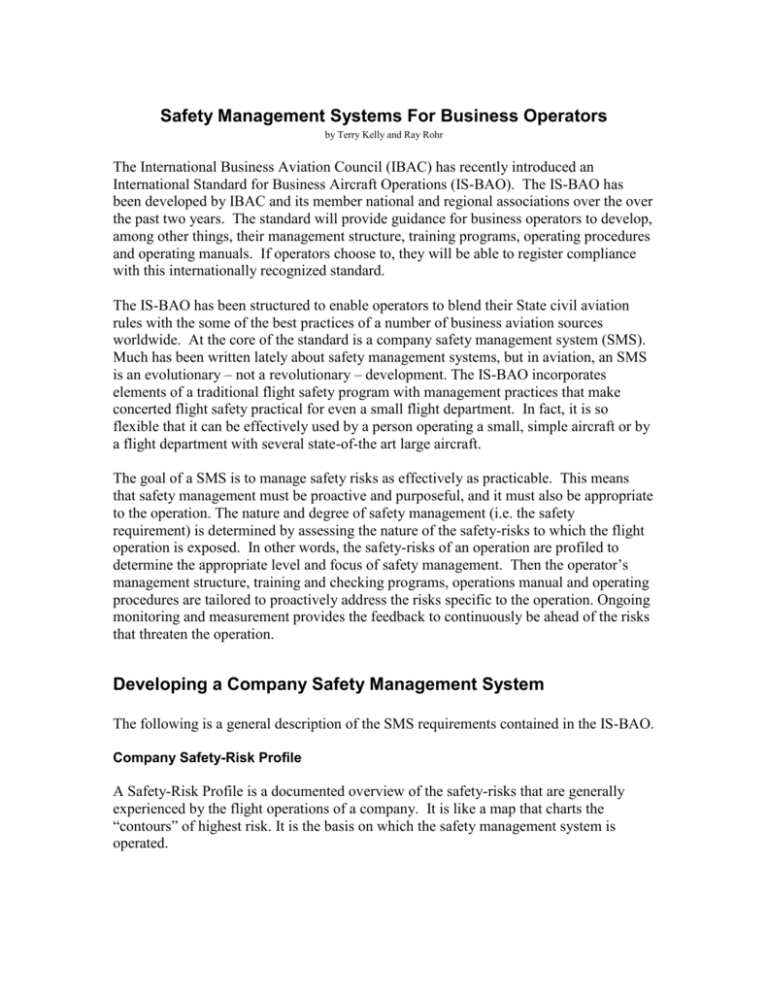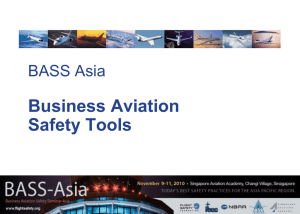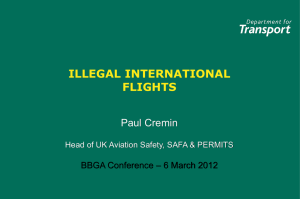Safety Management Systems For Business Operators
advertisement

Safety Management Systems For Business Operators by Terry Kelly and Ray Rohr The International Business Aviation Council (IBAC) has recently introduced an International Standard for Business Aircraft Operations (IS-BAO). The IS-BAO has been developed by IBAC and its member national and regional associations over the over the past two years. The standard will provide guidance for business operators to develop, among other things, their management structure, training programs, operating procedures and operating manuals. If operators choose to, they will be able to register compliance with this internationally recognized standard. The IS-BAO has been structured to enable operators to blend their State civil aviation rules with the some of the best practices of a number of business aviation sources worldwide. At the core of the standard is a company safety management system (SMS). Much has been written lately about safety management systems, but in aviation, an SMS is an evolutionary – not a revolutionary – development. The IS-BAO incorporates elements of a traditional flight safety program with management practices that make concerted flight safety practical for even a small flight department. In fact, it is so flexible that it can be effectively used by a person operating a small, simple aircraft or by a flight department with several state-of-the art large aircraft. The goal of a SMS is to manage safety risks as effectively as practicable. This means that safety management must be proactive and purposeful, and it must also be appropriate to the operation. The nature and degree of safety management (i.e. the safety requirement) is determined by assessing the nature of the safety-risks to which the flight operation is exposed. In other words, the safety-risks of an operation are profiled to determine the appropriate level and focus of safety management. Then the operator’s management structure, training and checking programs, operations manual and operating procedures are tailored to proactively address the risks specific to the operation. Ongoing monitoring and measurement provides the feedback to continuously be ahead of the risks that threaten the operation. Developing a Company Safety Management System The following is a general description of the SMS requirements contained in the IS-BAO. Company Safety-Risk Profile A Safety-Risk Profile is a documented overview of the safety-risks that are generally experienced by the flight operations of a company. It is like a map that charts the “contours” of highest risk. It is the basis on which the safety management system is operated. All operators require a Safety-Risk Profile, and each one is unique to the operator. It is used to identify the areas of highest safety-risk so that critical elements can be proactively identified and managed. A Safety-Risk Profile is a “living document” that must be periodically updated, particularly during times of operational change. As a minimum, the IS-BAO requires profiles to be updated every three years. The risk profile determines two things: a. the overall level of safety management (e.g. low, medium or high) needed for consistently safe flight operations; and b. the specific areas of higher risk that individual operators may experience. Examples of risk profiles and the related guidance material are contained in the IS-BAO. Those operations with higher risk profiles require more complete and thorough safety management strategies than those operating at lower risk levels. Even operations with a generally low risk profile may experience areas of high risk (and these areas will be indicated in the risk profile), indicating the areas where enhanced safety management activity should focus. Safety Policy The Safety Policy is a high level statement of desired corporate safety performance that provides: a. guidance to everyone in the company who has a direct or indirect impact on the company’s safety performance; and b. specific direction to enable safety management activity to be purposeful and directed. All operators require a Safety Policy. Sample Safety Policies are also contained in the IS-BAO. The organizational size of the company, the number of aircraft, and the complexity of the flight operations guide the contents of the policy. Safety Management Strategy A Safety Management Strategy is the flight department’s approach to the management of safety. It is the formal link between the risks identified on the Safety-Risk Profile and the remainder of the safety management system. As such, it provides a summary explanation of, and rationale for, the safety management activities of the operator. The strategy is the performance standard by which safety performance can be evaluated. All operators require a Safety Management Strategy. The organizational size of the company, the number of aircraft, and the complexity of the flight operations will guide the contents of the strategy. The tools described in the strategy must reflect the nature and level of risk identified in the safety profile. For instance, mitigation may specify training programs or procedures to address human factor risks. Single-pilot operators might develop and employ a “hazard checklist” during “high-risk profiled” flights to guide pre-flight and en-route decision-making. Multi-crew operators might also employ such a checklist customized to their operation, as might maintenance personnel. Similarly, the use of CRM-trained skills might effectively mitigate certain high human factor risks and operational risk factors. Similarly, risk strategies will be documented to address specific operational risks. For instance, explicit and stringent “go/no-go” criteria might be developed for operations into locations where weather information is difficult to obtain, weather conditions are changeable, or where there are no precision approach aids and the surrounding terrain is hilly or mountainous. Also, aircraft operating from remote locations during extreme weather seasons might carry additional survival and first aid equipment, and flight crew might be required to be proficient in survival and first aid skills. . The safety management strategy will be evaluated to ensure that it is appropriate and that it is being applied. Technical Management System The Technical Management System is the basis for consistency and reliability in an operation. It includes: a. systems for identifying all applicable laws, regulations and standards, including all approvals, authorizations, exemptions and permitted deviations; b. documentation identifying flight department personnel responsibilities and accountabilities for safety, and for the management of exemptions and permitted deviations; c. systems for ensuring that all flight department personnel have the necessary qualifications, skills, competencies, training, equipment and tools necessary to enable them to discharge their responsibilities in a safe manner; d. manuals or other documents addressing: i aircraft operations and maintenance procedures; ii personnel training programs and competency certification in accordance with State requirements; and iii aeronautical information. The IS-BAO requires all operators to have a Technical Management System that is appropriate for the organizational size of the company, the number of aircraft, and the complexity of the flight operations. Guidance material and the generic company operations manuals that accompany the IS-BAO can be used to develop systems that satisfy these requirements. Hazard Identification and Tracking System The purpose of a hazard identification program is to proactively identify and address potential deficiencies in safety management. It can include voluntary or confidential reporting programs, safety committee meetings, company data collection systems, brainstorming sessions, safety management system audits and safety reviews. A hazard tracking system is the mechanism to document, track and evaluate the effectiveness of remedial measures. The design of the system will depend on the size of the flight department and the nature of the operation. It should be complementary to other management systems. All operators require some type of hazard identification and tracking system. In a flight department with only a few people operating in a low-risk environment, it may be very rudimentary. Nevertheless, it should include a system to formally track identified hazards. Companies with high-risk factors (operational, technical or human) should have more comprehensive and aggressive hazard identification programs, including any or all of the following: a. hazard reporting programs; b. safety committees (within the company, or affiliated with industry associations, or the civil aviation authority); c. brain-storming sessions; and d. operational safety reviews. Companies should ensure that required actions are assigned a priority appropriate to the level of risk indicated in the company safety-risk profile. For instance, concerns regarding maintenance practices should be given high priority if maintenance has been identified as a safety-critical area in the company profile. Change Management Process The purpose of a change management process is to proactively identify and manage the safety risks that can accompany significant change. Examples of changes that might warrant active change management include: a. the introduction of a new aircraft type; b. significant change in the nature of the operation (e.g. dynamic business growth, a new operating environment, etc.); c. changes in hiring or scheduling practices; d. changes to organizational structures; or e. significant change in the maintenance contract; etc. A change management process normally involves some form of safety planning to demonstrate that hazards associated with the change will be systematically identified and managed, and that safety performance will be evaluated at an appropriate time and in an appropriate manner after the change has been implemented. Small operations and those that operate in stable low-risk environments need not maintain a Change Management Process. It is more appropriate for larger or complex operations, or those that frequently experience significant change. The process should describe the types of changes warranting examination, and document how the hazards and risk mitigation strategies will be developed, documented and evaluated. Findings should be tracked in the hazard tracking system, and when appropriate, used to update the Company Safety-Risk Profile. Safety Management Audit A Safety Management System Audit is an independent evaluation of the safety management system of a company. It may focus only on the company safety management system, or it may be a comprehensive audit to meet registration or regulatory requirements. In all cases, the prime purpose of the audit is to identify areas in which safety performance may be enhanced. The results are used to validate the corporate safety-risk profile, which in turn can be employed to evaluate corporate safety performance. Operators in a low risk environment and those that have a record of effective management of risks associated with the operation may need only be audited every three years. Those operating in a high-risk environment and those that without a record of effective risk management (e.g.; new operators) may need auditing annually. With demonstrated performance, the audit period can be extended. Audits should also be considered after significant changes in a company’s operational or management structure. Findings from the safety management audit should be acted upon with a priority that is appropriate to the degree of associated risk documented in the Company Safety-Risk Profile, and tracked in the hazard tracking system. Operational Safety Reviews An Operational Safety Review is an independent (external or internal to the flight department) examination of one or more parts of a company’s flight operation. The purpose of an operational safety review is to ensure that the critical aspects of an operation are being effectively managed. Examples of issues that can be examined by a Safety Review include company dispatch procedures, maintenance practices, operations from a particular site, and various operational practices and procedures. Findings from an operational safety review are tracked in the hazard tracking system, and may be used to update the corporate safety-risk profile and the Safety Management Strategy. In cases where there appears to be inappropriately high risk or ineffective risk management, an operator should conduct an Operational Safety Review. The findings should be addressed with a priority appropriate to the degree of associated risk documented in the Company Safety-Risk Profile. A company may wish to enhance its safety performance by voluntarily undertaking an operational safety review to examine a high-risk aspect of its operations. Conclusion The IS-BAO represents the latest evolution in diligently managing the safety of business aircraft operations. It is simple to develop and apply. It is easily adapted to suit the differing State rules and operating environments around the world. It offers sufficient flexibility that it can be applied by owner/operators of small aircraft; yet it is sufficiently rigorous to be the foundation for flight departments operating complex aircraft internationally. It is a standard that is well suited for the changing commercial and operating environments of the new century. Safety Management System Safety Policy Safety-Risk Profile Feedback Audits Hazard Identification Safety Reviews Safety Management Strategy Safety Management Activity Change Management Technical Management System Additional Reference Material Further information on the IS-BAO and on safety management systems and their application, may be found in the following sources: a. International Business Aviation Council. (2002) IS-BAO An International Standard for Business Aircraft Operations. IBAC, Suite 1633, 999 University Street, Montreal, Quebec, H3C 5J9, Canada. <www.ibac.org> b. Civil Aviation Authority, London. (2001) Safety Management Systems for Commercial Air Transport Operations. (CAP 712): Documedia, 37 Windsor Street, Cheltenham, England c. International Civil Aviation Organization. (1993) Human Factors Digest No. 10: Human Factors, management and Organization. ICAO, Montreal, Quebec, Canada. d. Reason, J. (1997) Managing the Risks of Organizational Accidents. New York: Ashgate e. Transport Canada. (2001) Safety Management Systems. (TP 13739) Public Works and Government Services, Ottawa, Ontario, Canada. f. Wood, Richard H. (1991) Aviation Safety Programs: A Management Handbook. Englewood, Colorado. Jeppesen Sandersen Inc.







